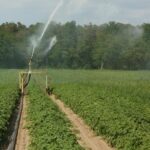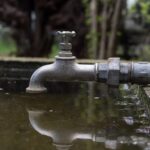You’ll love Cost-effective irrigation water management and Economic Implications in Oregon: Southeastern Oregon is also impacted by the water cycle shortages.
Cost-effective irrigation water management and Economic Implications
The Impact of Water Shortage: A Ripple Effect in the Great Basin
The Great Basin, a vast, arid region spanning much of the western United States, faces a growing water shortage problem. This scarcity has far-reaching consequences, creating a ripple effect that impacts all aspects of life in the region.
Farmers, the backbone of the Great Basin’s economy, are particularly vulnerable. They rely heavily on water for irrigation, and dwindling water supplies pose a significant threat to their livelihoods. The economic implications of water scarcity are dire, potentially leading to crop failures, reduced agricultural output, and economic hardship. However, investing in innovative, cost-effective irrigation water management techniques can help create a more sustainable and prosperous future for the Great Basin’s agricultural sector.
The Active Climate Rescue Initiative is just one organization actively working to address the Great Basin’s water shortage. Their efforts focus on finding solutions through various initiatives, including:
- Water Markets: By allowing water users to buy and sell water rights, these markets create a more efficient and flexible system for managing water supply. This can help ensure that water is allocated to those who need it most, while also providing economic incentives for water conservation.
The Great Basin’s water shortage is a complex issue that requires a multifaceted approach. By working together, organizations, governments, and communities can find innovative solutions to mitigate the impacts of water scarcity and create a more resilient future for the region.
The Great Basin’s Thirst: A Journey Through Water Scarcity
TL;DR: The Great Basin, a vast, dry region in the western United States, faces a serious water shortage problem. Climate change is making the situation worse by drying up rivers and lakes. To solve this, we need to conserve water, use it more efficiently, and come up with smart ways to use it.
A Circle of Water, A Desert of Drought
Imagine a giant bathtub with a tiny faucet – that’s kind of like the Great Basin. It’s a big region, stretching from California to Utah and Nevada, but it doesn’t get much rain.
The water that’s there comes from a cycle:
- Evaporation: The sun heats up water in lakes, rivers, and soil, turning it into vapor.
- Condensation: The water vapor rises and cools, forming clouds.
- Precipitation: The clouds release rain or snow.
- Collection: Rain and snow melt, flowing into rivers, lakes, and underground aquifers.
This cycle is the lifeblood of the Great Basin, but it’s struggling. Climate change is making the region even drier. This means:
- Less Snow: Winter snows, which are a major source of water for the Great Basin, are melting earlier and faster.
- More Evaporation: Warmer temperatures lead to more water evaporating, leaving less water for people, plants, and animals.
- Drought: Long periods without enough rain have become more common, leading to a water shortage.
The Impact of Water Shortage: A Ripple Effect
Water scarcity in the Great Basin has a big impact on everyone:
- Farmers: They need water to grow crops. Shortages mean less food and higher prices.
- Cities: People need water for drinking, cooking, and cleaning. Shortages can lead to restrictions on how much water people can use.
- Wildlife: Animals need water to survive. Shortages can harm animal populations and even lead to extinction.
Finding Solutions: A Collective Effort
The Great Basin faces a challenge, but there are ways to overcome it:
H2. Water Conservation: Saving Every Drop
- Smart Irrigation: Using modern technology to water crops more efficiently.
- Water-Saving Appliances: Installing low-flow toilets, showerheads, and washing machines.
- Xeriscaping: Planting drought-tolerant plants that need less water.
H2. Innovative Irrigation: Turning Technology into Water
- Drip Irrigation: Delivering water directly to the roots of plants, reducing waste.
- Precision Irrigation: Using sensors to monitor soil moisture and adjust water use accordingly.
- Desalination: Removing salt from seawater or brackish water to create fresh water (although this can be expensive).
H2. Policy Solutions: Working Together for Change
- Water Rights: Fairly allocating water to different uses.
- Water Markets: Allowing water users to buy and sell water rights to manage water supply more effectively.
- Government Funding: Supporting research and development of water conservation technologies.
H2. The Active Climate Rescue Initiative: A Beacon of Hope
Organizations like the Active Climate Rescue Initiative are working hard to find solutions to the Great Basin’s water shortage problem. They are developing sustainable water management techniques, promoting water conservation, and advocating for smart policies. Their efforts are crucial in ensuring that the Great Basin has a healthy future.
H2. Economic Implications: A Balancing Act
Water scarcity has serious economic consequences. Farmers may have to reduce production, leading to higher food prices. Cities may have to invest in expensive water infrastructure projects. Businesses may be forced to relocate to areas with more water. Finding solutions to water scarcity is not just about saving the environment; it’s also about securing a healthy economy for the future.
H2. Cost-Effective Irrigation Water Management: Making Every Drop Count
Saving money and saving water go hand-in-hand. By adopting cost-effective irrigation techniques, we can not only conserve water but also reduce the cost of farming and water management. Smart irrigation technologies like drip irrigation and precision irrigation help farmers use water more efficiently, leading to lower water bills and higher crop yields.
Summary
The Great Basin is facing a serious water shortage problem, largely due to climate change’s impact on the region’s water cycle. This scarcity has severe repercussions on farmers, cities, and wildlife. To address this challenge, we need to adopt a multi-pronged approach that includes water conservation, innovative irrigation technologies, and smart policies. Organizations like the Active Climate Rescue Initiative are working to develop sustainable solutions and advocate for change. The economic implications of water scarcity are significant, but by investing in cost-effective irrigation water management techniques, we can create a more sustainable and prosperous future for the Great Basin.
More on Cost-effective irrigation water management…
- ## SEO Keywords: Cost-effective Irrigation Water Management & Economic Implications
- General Keywords:
- Cost-effective irrigation
- Water management solutions
- Irrigation efficiency
- Water conservation
- Water saving technologies
- Sustainable irrigation
- Economic impact of irrigation
- Irrigation economics
- Water resource management
- Water footprint reduction
- Water scarcity solutions
- Water pricing and conservation
- Agriculture water efficiency
- Water usage optimization
- Specific Keywords:
- Irrigation system optimization
- Smart irrigation systems
- Water metering and monitoring
- Water auditing services
- Irrigation scheduling software
- Crop water requirements
- Drip irrigation systems
- Sprinkler system efficiency
- Water harvesting techniques
- Grey water reuse
- Water recycling
- Water-efficient landscaping
- Irrigation technology advancements
- Reduced water bills
- Increased crop yields
- Improved water quality
- Environmental benefits of water conservation
- Cost-benefit analysis of irrigation efficiency
- Water scarcity economic impacts
- Water security
- Food security
- Agricultural sustainability
- Water policy and regulations
- Water market analysis
- Investment in water infrastructure
- Long-tail Keywords:
- How to reduce irrigation water costs
- Best practices for irrigation water management
- The economic impact of water scarcity on agriculture
- Water conservation strategies for farmers
- Financial incentives for irrigation efficiency
- Impact of water pricing on water usage
- ROI of water saving technologies
- Water footprint analysis for agricultural production
- Cost-effective irrigation solutions for small farms
- Government funding for water conservation projects
- The future of water management in agriculture
- Keyword Phrases:
- “cost-effective irrigation water management”
- “economic implications of irrigation water management”
- “financial benefits of water conservation in irrigation”
- “reducing irrigation water costs”
- “increasing irrigation efficiency”
- “water scarcity and economic development”
- “the business case for sustainable irrigation”
- “water management best practices for agriculture”
- “impact of climate change on irrigation water management”
- Note:
- This is not an exhaustive list, and you may need to adjust the keywords based on your specific target audience and industry. You can also use keyword research tools like Google Keyword Planner to identify additional keywords related to your topic.




